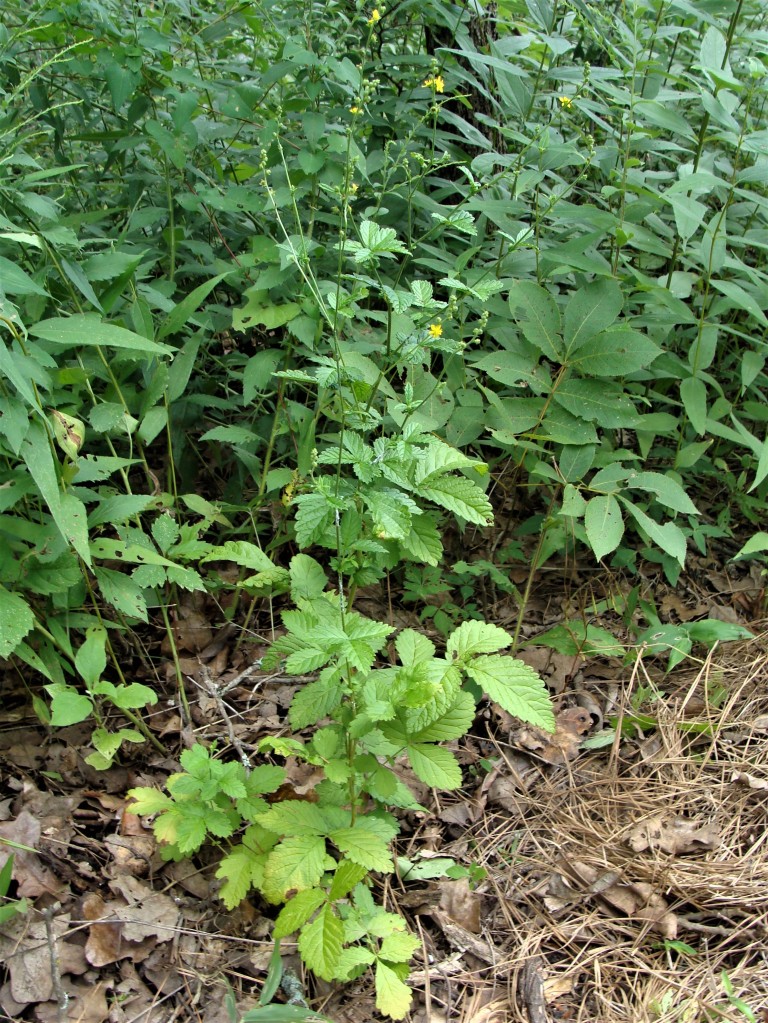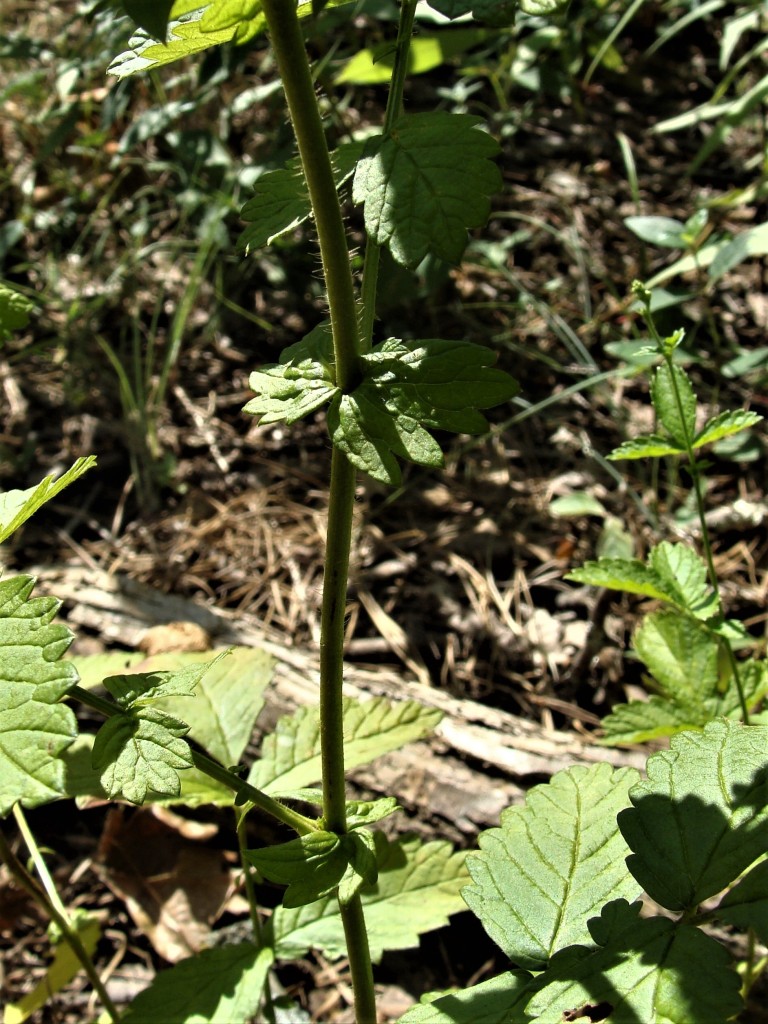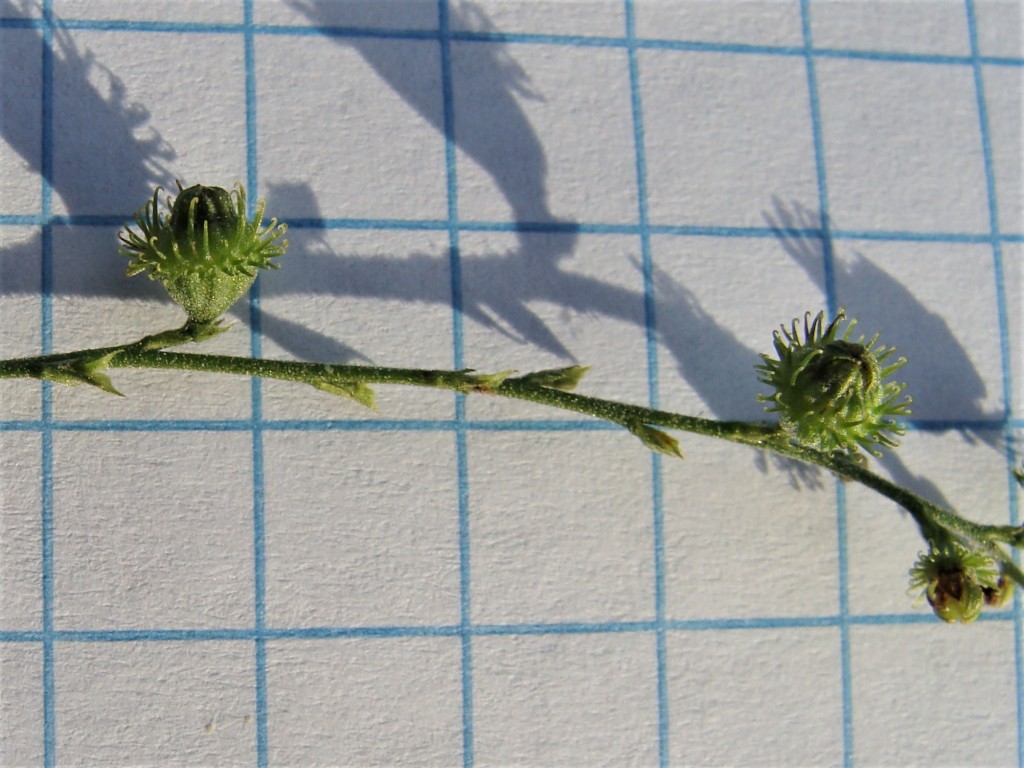Woodland agrimony (Agrimonia rostellata) of the Rosaceae (Rose) family has leafy stems terminating with a raceme(s) of small yellow flowers. The genus name is a corruption of Argemone, the botanical name of the prickly poppy. The specific epithet is based on a Latin word for “beaks,” in reference to the fruit shape. In the U.S., the species occurs from eastern Texas to eastern Kansas in a broad sweep all the way to the eastern seaboard from South Carolina to Massachusetts. In Arkansas, it occurs statewide except for some portions of the Mississippi Alluvial Plain and the West Gulf Coastal Plain. Habitat preference is for partially sunny areas with well-drained, rich to sandy soils of mixed woodlands and woodland edges and openings. Plants are also called beaked agrimony.
The plant has a small caudex with long horizontally trending fibrous roots to 5 or more inches long and several long descending ropy roots of similar length. During summer months, the caudex produces large white buds which appear as new stems in late winter.

This herbaceous perennial, to 2½ feet tall, has one to several erect (sunny sites) to reclined (shady sites) sparsely pubescent stems. Alternate compound cauline (stem) leaves are distinctively odd pinnate, with one to three pairs of opposite primary (large) leaflets, a similar number of opposite secondary (much smaller) leaflets, and a primary terminal leaflet. Secondary leaflets occur as one or several pairs between the primary pairs and may also occur below the lowermost primary pair. Mid-stem primary leaves may be to 5 inches long and 4½ inches wide. All leaflets are sessile (the stalk of the terminal leaflet is the final segment of the rachis, not a petiole).


Leaves are glabrous above, while the lower leaf surface has sparse long hairs along the main veins and crowded, minute glandular pubescence between veins. Except for the smallest secondary leaflets, all leaflet margins are prominently dentate. Pairs of stipules subtending the leaves may be small and elliptical or larger––to 5/8 inch by 5/8 inch––recurving around the stem like wings. Paired leaflets and stipules are mirror images of each other. The sparse hairs that occur on stems extend onto the petioles and rachises.


The inflorescence, flowering primarily in July, comprises racemes that grow from the upper leaf axils. Total length of an inflorescence may be 1+ feet with individual racemes to 5 inches long. On a typical plant, stems transition apically into an unbranched raceme. On more robust plants, branched stems may produce several racemes which in turn may divide into secondary racemes. The erect to slightly twisty racemes bear up to 20 small, well-spaced flowers. The raceme rachis is covered with minute, stubby glandular hairs.
At anthesis, the solitary ascending flowers are about ¼ inch wide with 5 sepals, 5 petals, and 5-15 stamens attached at the rim of a densely bristly, cup-shaped hypanthium. Two pistils with superior ovaries are hidden in the hypanthium, their 2 erect light yellow styles emerging with star-shaped stigmas to the level of the anthers. The hypanthium and outer (lower) surface of the sepals are covered by minute glandular hairs. After blooming, petals and stamens quickly drop off and sepals reclose to cover the domed hypanthium.


The slightly nodding, ovoid fruits consist of the hypanthium with the persistent sepals reclosed across the hypanthium’s domed apex (forming the knob-like “beak”). The spiky protrusions present during flowering persist on the fruit as hardened, hooked bristles. Fruits attach to passing animals (and humans) for seed dispersal. Fruits, ⅛+ inch long and wide, contain 1-2 seeds.

In a shady to partially sunny garden or natural area, if this small deciduous perennial was interspersed with other leafy plants, it would hardly be noticed. However, as a specimen plant, it would present its interesting growth pattern and add an interesting leafy texture. Woodland agrimony does not seem to be an aggressive self-seeder and does not seem to be eaten by deer.
Three other species of the genus occur in Arkansas: low agrimony (A. microcarpa), southern agrimony (A. parviflora), and downy agrimony (A. pubescens). These species also have small yellow flowers in racemes and similar odd-pinnate leaves. Woodland agrimony can be distinguished by its 1) long straight cauline hairs, 2) ovate to elliptic leaflets that are mostly glabrous above and densely covered with minute glandular hairs beneath, and 3) fruits with a bowl-shaped lower half and bristles that are directed outward.
Article and photographs by ANPS member Sid Vogelpohl

